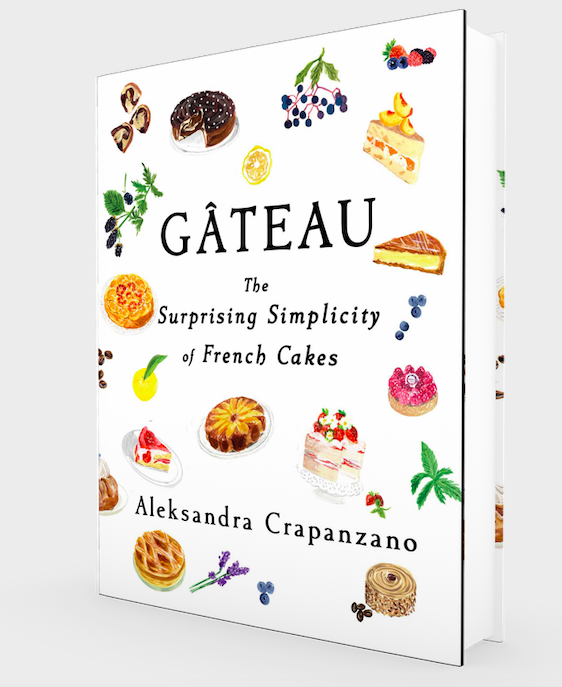Baking is a whole other skill set in the kitchen, when precision rules over improvisation. French pastry brings next level technique and engineering. But French home cooks don't bother to compete with pastry chefs. They approach making cakes at home with the kind of simple panache seen in the way they put an outfit together. Food writer Aleksandra Crapanzano shares this surprisingly practical approach to throwing together a simple yogurt cake to a holiday Bûche De Noël at home. Her latest book, "Gâteau: The Surprising Simplicity of French Cakes."
Mocha Bûche de Noël
Mocha Yule Log
When I was a little girl, this yule log was always my favorite. Now the coffee, no longer illicit, isn’t quite so exotic, but this bûche remains my preferred way to end Christmas din- ner. A dedicated espresso drinker, I brush a little extra onto the génoise before blanketing it with buttercream. A dusting of confectioners’ sugar and cocoa tends to be my only decora- tion, with perhaps some chocolate-covered espresso beans scattered about. The 364 days a year that are not Christmas, you could make it as a simple rouleau and add a bit of cinnamon or cardamom or rum, maybe a thin drizzle of ganache. As well you should! I make it only on Christmas, as I relish the intensity of experience that comes with ritual and with tasting something I love merely once a year.
The recipe may look elaborate but, broken down, it’s quite simple. All you are really doing is making a génoise in a sheet pan, rolling it up so it stays malleable, brushing it with coffee, slathering it with buttercream, rolling it back up, running the tines of a fork over the buttercream, dusting it with sugar and cocoa, et voilà! You will need a candy thermometer and two 10 x 15-inch rimmed baking sheets.
Ingredients
ALMOND GÉNOISE
- 4 large eggs, at room temperature
- 2⁄3 cup / 132 grams granulated sugar
- 1 teaspoon almond extract
- 1⁄4 teaspoon fine sea salt
- 1 cup / 120 grams cake flour
- Confectioners’ sugar, as needed
MOCHA BUTTERCREAM
- 4 large egg whites, at room temperature
- 85 grams dark chocolate, preferably around 70% cacao
- 3⁄4 cup / 150 grams granulated sugar
- 2/3 cup water
- 1⁄2 teaspoon instant espresso powder
- 1⁄2 teaspoon vanilla extract
- 3⁄4 cup unsalted butter, at room temperature
TO ROLL AND SOAK
- Confectioners’ sugar, as needed 2 tablespoons espresso or 1 tablespoon espresso mixed with 1 tablespoon of dark rum
DECORATION
- 1 tablespoon unsweetened cocoa powder
- 2 tablespoons confectioners’ sugar
- Chocolate-covered espresso beans, for fun, optional
Instructions
- FOR THE ALMOND GÉNOISE: Preheat the oven to 400°F. Butter the sides of a 10 x 15-inch rimmed baking sheet or jelly roll pan and line it with parchment paper. In a stand mixer or using handheld electric beaters, whisk the eggs until thick and foamy, about 5 minutes at medium speed. Add the granulated sugar, almond extract and salt and, increasing the speed to high, beat for 2 minutes.
- Place a sieve over the mixing bowl and sift in the cake flour, about a third at a time, folding it in with a rubber spatula until no streaks of flour remain. Pour the batter into the prepared pan and, with a light touch, spread it into an even layer. Bake for 12–14 minutes, or until the center springs back when gently pressed and the edges have just started to pull away from the pan.
- Let the cake cool for about 5 minutes. Dust the entire surface with a little confectioners’ sugar. This will help to prevent sticking. Cover the cake with a clean tea towel and the back of a second jelly roll pan and invert the cake onto the back of the second pan. Peel off the parchment and dust this side with confectioners’ sugar as well. Turn the cake so that you are facing its length, not its width. Use the tea towel to roll the cake. The towel both helps the rolling and mimics the eventual filling. Set the cake aside to cool to room temperature, while rolled and wrapped in the towel, seam side down.
- FOR THE MOCHA BUTTERCREAM: In a stand mixer or using handheld electric beaters, beat the egg whites until they form soft peaks. Set aside. Melt the chocolate in a microwave or in a double boiler and set aside. In a small saucepan, bring the sugar and water to a boil and cook to 240°F on a candy thermometer, or the soft-ball stage.
- Restart the mixer, beating the egg whites on high speed. With the mixer running, pour the hot sugar syrup down the side of the bowl and into the eggs in a slow but steady stream. Pour the melted chocolate, espresso powder and vanilla into the egg whites and continue beating until the meringue has fully cooled to room temperature, about 5 minutes. Keeping the mixer on high, add the butter to the meringue, a tablespoon or two at a time, and continue to beat until integrated. Note: If the buttercream becomes runny during this process, refrigerate it until it is cool to the touch. Then continue the process of beating the butter into the meringue.
- ASSEMBLY: Unroll the cake and brush it with the espresso. Allow the liquid to be absorbed, then spread the cake with about half of the buttercream, smoothing it into an even layer and leaving an inch at the bottom seam unfrosted. Gently roll the cake back into a log. If you’d like, cut a thin piece off each end on the bias. This makes it a bit neater. Ice the log with the remaining buttercream. Drag a dinner fork down the length of the log so that the tines create the impression of a tree bark. Repeat until the entire log is etched this way.
- Chill the cake before serving to allow the buttercream to set. It can be made up to 1 day in advance and kept covered with a tent of aluminum foil. Right before serving, combine the cocoa powder and confectioners’ sugar and lightly dust this over the cake to give the impression of snow that’s fallen on a tree trunk. Scatter about some chocolate-covered espresso beans, if you have them.

"The French are wise enough to leave complicated cooking to the pros," says food writer Aleksandra Crapanzano. Photo by Melissa Foreman.

A recipe for yogurt cake, taught to kindergartners in France, and simple pound cakes are included in "Gâteau: The Surprising Simplicity of French Cakes." Photo courtesy of Simon & Schuster.
